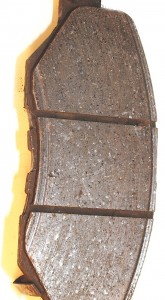
Choosing to install a new set of pads should be the last option when trying to solve a noise complaint. Most of the time (if you used a decent set of pads), the pad are not to blame it is the components or installation procedures. Returning pads is getting more and more difficult. Some friction suppliers have even eliminated returns for some of their lines. Also, some counter pros will grill why, even if you have the receipt.
Look at the surface of the pad for any discoloration, cracking or glazing. These are signs of contamination of the friction surface. In order for a pad to operate quietly, it must have a consistent coefficient of friction across the face of the pad that comes in contact with the rotor. If an edge or half of the pad is contaminated by brake lube, metal shavings from the lathe or even friction material from to old set of pads, it will cause a noise comeback.

Also, cheap brake pad will flex due to a sub-standard backing plate. This will also cause discoloration, cracking or glazing due to uneven pressure on the friction surface.
Most ceramic pads transfer a layer of friction material to the rotor. This can improve rotor life and braking performance. If the brake pads are changed and the transfer layer of material is left on the rotor, the friction material can become contaminated and the new material might not transfer its material to the rotor. Some friction materials might be compatible, but chances are the two materials will have problems.
When a rotor is machined or a new rotor is installed, it should be cleaned. The surface should be free of shavings and anti-corrosion coatings. These materials can contaminate the pad and affect the levels of friction across the pad.
One place you never, ever want to get any grease on is the friction surface of a brake lining — which is another reason for not using low-temperature or petroleum-based lubricants which can melt, run off and foul the linings. Grease contaminated shoes or pads will be grabby and usually cause a brake pull to one side. This is why any lubricant should be used sparingly.
In most cases, the contamination can’t be removed from the pad. The pad should be replaced and the rotor machined.